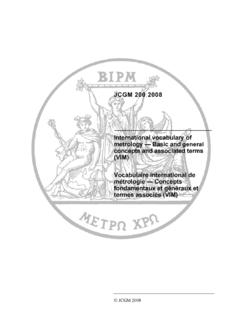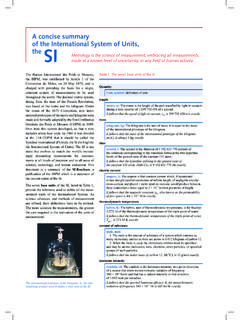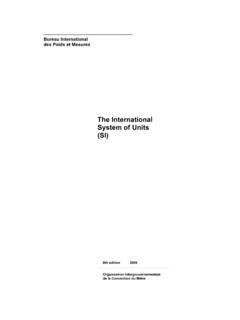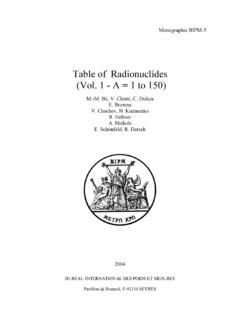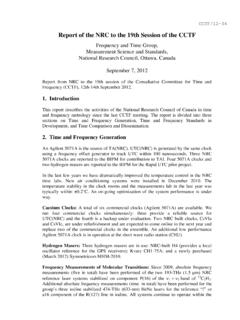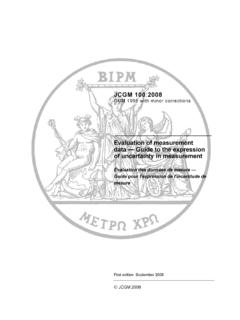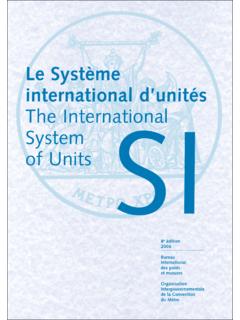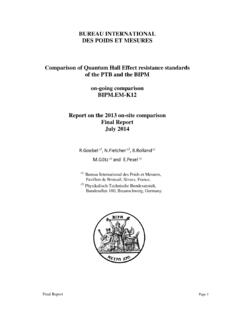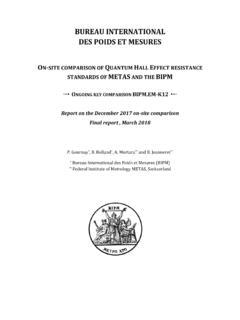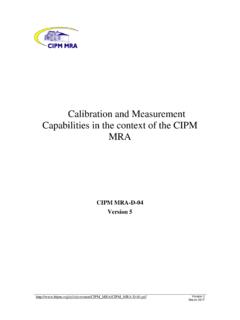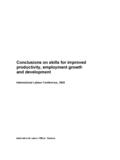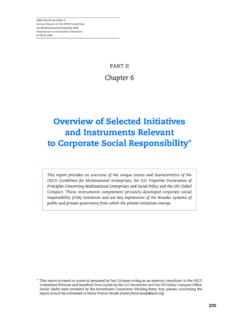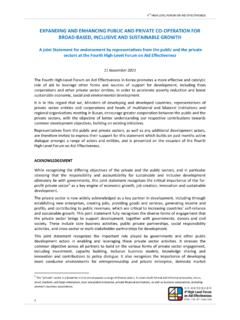Transcription of BIPM, OIML, ILAC and ISO: Joint Declaration on ...
1 2 Joint BIPM, OIML, ILAC and ISO Declaration ON metrological traceability 1. Background The International Bureau of Weights and Measures (BIPM), the International Organization of Legal Metrology (OIML), the International Laboratory Accreditation Cooperation (ILAC) and the International Organization for Standardization (ISO) are four internationally recognized bodies which are responsible for metrology, accreditation and standardization world-wide. Recognizing the importance of metrologically traceable measurement results to the core missions of our Organizations, we have drawn up this policy document which we encourage our Members, as well as others for whom traceability is important, to adopt. We also encourage other bodies to declare their support for the principles and practices embodied in this Declaration wherever possible. This document builds on the tripartite statement1 issued by the BIPM, the OIML, and the ILAC on 23 January 2006 on the relevance of various international agreements on metrology to trade, legislation and standardization.
2 2. The importance of metrological traceability We assert that international consistency and comparability of measurements are required if the missions of our Organizations are to be achieved. In particular, measurement comparability is an essential characteristic of an international measurement system within which measurement results can be universally accepted. This international consistency and comparability can only be guaranteed if measurement results are traceable to internationally recognized references. In general, these references are the International System of Units (SI), but where such traceability is not yet feasible, measurement results should be traceable to other internationally agreed references (for example, hardness scales, and reference standards established by the World Health Organization). All four intergovernmental or international bodies collaborate in the Joint Committee for Guides in Metrology, (JCGM) which develops common documents.
3 Two JCGM documents are key to this Declaration : Uncertainty in Measurement - Part 3 - Guide to the Expression of Uncertainty in Measurement (GUM) JCGM 100, OIML G 1-100 and ISO Guide 98-3 which promotes a consistent and common approach to the evaluation of measurement uncertainty in a variety of metrological situations; and the "International vocabulary of metrology - Basic and general concepts and associated terms (VIM) JCGM 200 V2, OIML V 2-200 and ISO/IEC Guide 99. In particular, the VIM defines metrological traceability as: property of a measurement result whereby the result can be related to a reference through a documented unbroken chain of calibrations, each contributing to the measurement uncertainty . metrological traceability therefore embodies the concepts of measurement uncertainty and calibrations against a hierarchy of reference standards.
4 The establishment and application of these concepts require the involvement of a number of parties: The International Bureau of Weights and Measures (BIPM) has the mission of establishing world-wide uniformity of measurement and the General Conference on Weights and Measures (CGPM) has the authority of approving the definitions of the SI. The BIPM, under the responsibility of the International Committee for Weights and Measures (CIPM) publishes the "SI brochure", which is an essential reference document for the application and correct use of the SI units. 3 The National Metrology Institutes (NMIs) are tasked with the realization, maintenance, improvement and dissemination of the SI units via traceable calibration and measurement services based on their Calibration and Measurement Capabilities (CMCs). The International Committee for Weights and Measures (CIPM), recognizing the need to demonstrate, unambiguously, the equivalence of such national realizations, and therefore of the calibration certificates issued by NMIs, drew up a Mutual Recognition Arrangement.
5 This "CIPM MRA" provides a framework within which all participants validate and recognize the CMCs of other participants. These peer-reviewed CMCs are listed in the BIPM's key comparison data base (KCDB). To provide the technical basis for this listing, participating NMIs are required to take part in regular "key comparisons" of national measurement standards and have their CMC claims validated through the peer review process of the CIPM MRA. This process includes the approval of a reviewed quality system (accredited or self declared) which conforms to appropriate internationally recognized standards, usually ISO/IEC 17025 and ISO Guide 34 for the production and certification of reference materials. The International Organisation of Legal Metrology (OIML) promotes the global harmonization of legal metrology laws and procedures and provides its Members with guidance with respect to their national legislation, including that measurements used for trade and regulatory purposes should be made using standards legally traceable to the SI2.
6 It has developed a world-wide technical infrastructure that provides its Members with metrological guidelines for the alignment of national requirements concerning the manufacture and use of regulated measuring instruments. This infrastructure supports the legal traceability of measurements used in regulated activities such as trade, health care, monitoring the environment, etc. OIML has also introduced a Mutual Acceptance Arrangement (MAA) within which Declarations of Mutual Confidence (DoMC s) can be signed under which signatories declare mutual confidence in the type evaluation data underpinning certificates of conformity with an OIML Recommendation. Participants who issue OIML Certificates under the MAA shall have their quality system evaluated either by accreditation bodies or by peer review. The International Laboratory Accreditation Cooperation (ILAC) aims to promote the mutual recognition of test and measurement certificates issued by laboratories accredited by national accreditation bodies to internationally accepted standards for technical competence.
7 ILAC members are peer evaluated and become signatories to the ILAC Arrangement. The ultimate aim of the Arrangement is increased use and acceptance by industry as well as governments of the results from accredited laboratories, including results from laboratories in other countries. In standards such as ISO/IEC 17025, metrological traceability of measurement results to primary realizations of the SI (often referred to as national measurement standards) is required, and in other similar standards traceability should either be to the SI or to other agreed international references where SI traceability is not, or not yet, possible. The International Organization for Standardization (ISO), as the world's major standardization body, is responsible for the publication of a range of written standards and guides that apply to manufacture and testing of various products, and the provision of various services.
8 In many cases, calibration and testing form an integral part of the requirements of the standards, and or guides. ISO harmonizes its terminology with the VIM and frequently incorporates measurement-related clauses in these standards. As ISO is responsible, together with the International Electrotechnical Commission, IEC, for ISO/IEC 17025 it endorses the principle of traceable measurement to the SI. Moreover, ISO participates in GUM activities that set out a common approach to the evaluation and estimation of measurement uncertainty. The concept of measurement uncertainty may be applied when deciding on conformity with a specified requirement (often in the form of tolerance limits). This concept may be applied in legal metrology. ISO works closely with the International Electrotechnical Commission (IEC), which has general responsibility for electrical standards, and the International Telecommunications Union (ITU), which has general responsibility for telecommunication standards.
9 ISO, IEC and ITU work cooperatively through the World Standards Cooperation (WSC). 4 metrological traceability is therefore one of the elements that establishes international confidence in the world-wide equivalence of measurements. At the same time, the framework described above enables legislators, regulators and exporters/importers to take advantage of an international set of mutually supportive systems which demonstrate equivalence of measurements and therefore can significantly reduce technical barriers to trade (TBTs) which might result from lack of equivalence. The BIPM, OIML, ILAC, and ISO endorse the following recommendations: in order to be able to rely on their international acceptability, calibrations should be performed in National Metrology Institutes who should normally be signatories to the CIPM MRA3 and have CMCs published in the relevant areas of the KCDB4 or in laboratories accredited by accreditation bodies which are signatories to the ILAC Arrangement5; measurement uncertainty should follow the principles established in the GUM; the results of the measurements made in accredited laboratories should be traceable to the SI2; NMIs providing traceability for accredited laboratories should normally be signatories to the CIPM MRA and have CMCs published in the relevant areas of the KCDB.
10 Within the OIML s MAA, accreditation should be provided by bodies which are signatories to the ILAC Arrangement and the above policies on traceability to the SI should be followed; The above principles should be used whenever there is a need to demonstrate metrological traceability for international acceptability. 3. Use of this Declaration These principles underpin a world measurement system which provides a robust, internationally accepted framework within which users can have confidence in the validity and acceptability of measurements results. BIPM, OIML, ILAC and ISO strongly urge legislators and regulators to refer to the Arrangements described earlier in this Declaration and also to accept measurement results made within this system, thereby helping avoid technical barriers to trade. We also invite interested parties to endorse these principles and to make use of them in their own work.
